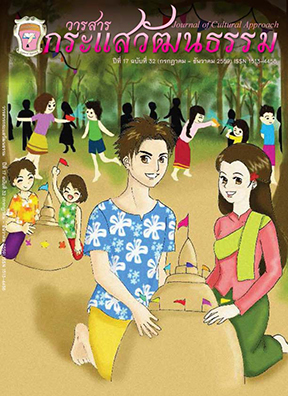Social Space Construction of Spirit’s Isan
Main Article Content
Abstract
This article is an attempt to reflect the system spiritualism context of Isan base on why the belief persists amid a cultural change and this faith is important in the adoption of social control. This study used qualitative research methods, data collection in the Northeast region (Isan) through understanding and study of spiritualism and the process of creating a social space. The result found; the Isan communities have spiritualism through pass on and processes of socialization that expressed in the form of traditions and rituals. The goal was to express gratitude, the prosperity of the joy of living, including a mechanism of social control.
Article Details
How to Cite
Potiwan, P. (2016). Social Space Construction of Spirit’s Isan. Journal of Cultural Approach, 17(32), 100–110. retrieved from https://so02.tci-thaijo.org/index.php/cultural_approach/article/view/72412
Section
Academic Article
Proposed Creative Commons Copyright Notices
1. Proposed Policy for Journals That Offer Open Access
Authors who publish with this journal agree to the following terms:
- Authors retain copyright and grant the journal right of first publication with the work simultaneously licensed under a Creative Commons Attribution License that allows others to share the work with an acknowledgement of the work's authorship and initial publication in this journal.
- Authors are able to enter into separate, additional contractual arrangements for the non-exclusive distribution of the journal's published version of the work (e.g., post it to an institutional repository or publish it in a book), with an acknowledgement of its initial publication in this journal.
- Authors are permitted and encouraged to post their work online (e.g., in institutional repositories or on their website) prior to and during the submission process, as it can lead to productive exchanges, as well as earlier and greater citation of published work (See The Effect of Open Access).
Proposed Policy for Journals That Offer Delayed Open Access
Authors who publish with this journal agree to the following terms:
- Authors retain copyright and grant the journal right of first publication, with the work [SPECIFY PERIOD OF TIME] after publication simultaneously licensed under a Creative Commons Attribution License that allows others to share the work with an acknowledgement of the work's authorship and initial publication in this journal.
- Authors are able to enter into separate, additional contractual arrangements for the non-exclusive distribution of the journal's published version of the work (e.g., post it to an institutional repository or publish it in a book), with an acknowledgement of its initial publication in this journal.
- Authors are permitted and encouraged to post their work online (e.g., in institutional repositories or on their website) prior to and during the submission process, as it can lead to productive exchanges, as well as earlier and greater citation of published work (See The Effect of Open Access).
References
[1] Eoseewong, Nidhi. (2015). Religious Emotion. Matichon Weekly, 35(1801), 30.
[2] Leach, E. R. (1954). The Structural Study of Myth and Totemism. London : Tavistock Publications.
[3] Meton, R. K. (1975). Social Theory and Social Structure. New York : The Free Press of Glenche.
[4] Limtragoon, Prayong. (1993). Tradition Health Beliefs & Health Seeking Behavior of the People in Huay Sapad Village Chom-Thong District, Chiang Mai Province. Chiang Mai : Chiang Mai University Press.
[5] Ramitanon, Chalardchie. (1984). Phijaonai. Bangkok : Prayupopset Print.
[6] Tambiah, S. J. (1975). Buddhism and the Spirit Cult, in North-East Thailand. Cambridge : Cambridge University Press.
[7] Terwiel, B. J. (1981). The Tai of Assam and Ancient Tai Ritual. Gaya : Centre for Southeast Asian Studies.
[8] Turner, V. W. (1970). The Ritual Process. U.S.A. : University of Chicago.
[9] Wanliphodom, Srisak. (1984). “Ghost Worship in Thailand,” Culture and Arts Journal. 5(4), 16-17 : February 1984. Bangkok : Prasanmitr Print.
[10] Wongthes, Pranee. (1992). “The Anthropological Study of Sexual Orientation Makeover Theory. Related to Sex and Cultural. 1-11. Nakhonpathom : Silpakorn University Print.
[2] Leach, E. R. (1954). The Structural Study of Myth and Totemism. London : Tavistock Publications.
[3] Meton, R. K. (1975). Social Theory and Social Structure. New York : The Free Press of Glenche.
[4] Limtragoon, Prayong. (1993). Tradition Health Beliefs & Health Seeking Behavior of the People in Huay Sapad Village Chom-Thong District, Chiang Mai Province. Chiang Mai : Chiang Mai University Press.
[5] Ramitanon, Chalardchie. (1984). Phijaonai. Bangkok : Prayupopset Print.
[6] Tambiah, S. J. (1975). Buddhism and the Spirit Cult, in North-East Thailand. Cambridge : Cambridge University Press.
[7] Terwiel, B. J. (1981). The Tai of Assam and Ancient Tai Ritual. Gaya : Centre for Southeast Asian Studies.
[8] Turner, V. W. (1970). The Ritual Process. U.S.A. : University of Chicago.
[9] Wanliphodom, Srisak. (1984). “Ghost Worship in Thailand,” Culture and Arts Journal. 5(4), 16-17 : February 1984. Bangkok : Prasanmitr Print.
[10] Wongthes, Pranee. (1992). “The Anthropological Study of Sexual Orientation Makeover Theory. Related to Sex and Cultural. 1-11. Nakhonpathom : Silpakorn University Print.


